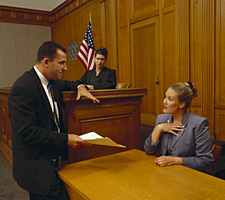Archival Notice
This is an archive page that is no longer being updated. It may contain outdated information and links may no longer function as originally intended.
Home | Glossary | Resources | Help | Contact Us | Course Map
Providing scientific opinions in courts of law requires many of the same verbal and written tactics described above with few modifications. For example, the content and format of the report is determined by the Quality Assurance Standards and laboratory procedures, which may require you to write in a manner that is not best for communicating your points of view. You may also be attempting to communicate in an environment that severely limits your ability to control your presentation. For example, you may be asked to respond to complex questions with either a "yes" or "no" response. Likewise, while judicious use of visual material can reinforce messages and serve to breakup the monotony of scientific jargon, you must be aware that the court may not allow it.
Additionally, you may be required to communicate under a range of circumstances. Typically these are preliminary communications, depositions, court testimony, and the written report. For example, the first interaction in forensic biology DNA cases generally occurs during preliminary communication with investigators and prosecutors. These communications are principally verbal and may seem informal. Be aware that the person you are talking to will selectively hear your comments and record them subjectively without qualification. In many jurisdictions, the next communication may be in the context of depositions. The deposition is a written record of your verbal statements and another instance when you will have to deal with contrasting requirements for effective verbal and written communications. Direct and cross examination during court testimony are entirely verbal, but you have no control over the questions and frequently have limited control over how you can express your responses. Thus, apart from the formatting restraints of the Quality Assurance Standards and laboratory procedures, the written report is the only communication method that is entirely under your control.
Continuous improvement over time
Much like getting to Carnegie Hall in New York City, the only way to improve communication skills is through practice. However, the quality of our practice makes a significant difference. Each of the previous sections provides advice on how to become a better speaker or writer. For verbal presentations, communicators are urged to know the background, interest level, diversity, and size of their audience before preparing talks. The use of visual materials should be designed to complement major points rather than direct attention away from presenters. Body language, gestures, and movement help engage and sustain your audience, along with the appropriate use of voice intonations and inflections. Written documents typically ask more of communicators but technical writing need not be bland or boring. Writers also must consider audience traits as well as the logic of their presentations and the clarity and compelling nature of their prose.
One option for charting your improvement is through the use of a communications log. Using this device, communicators maintain a written diary of each and every time they present their ideas verbally or in writing to their professional colleagues. The log is best kept in an electronic form or spreadsheet. While people differ in the columns they prefer, examples include day, date, time of the day (to see if your performance varies by time), intended audience (to see if you are better with small or large/professional or lay audiences), length of presentation (to see if you fade in the long run or just hit your stride), type of presentation (to see if verbal or written forms differ), self-perceptions (to see if you believe things went well or poorly), others-perceptions (to see if the audience agrees), and lessons learned (to see what you can do differently or the same next time). Remember that growth in your abilities only occurs through some form of reflection!
Additional Online Courses
- What Every First Responding Officer Should Know About DNA Evidence
- Collecting DNA Evidence at Property Crime Scenes
- DNA – A Prosecutor’s Practice Notebook
- Crime Scene and DNA Basics
- Laboratory Safety Programs
- DNA Amplification
- Population Genetics and Statistics
- Non-STR DNA Markers: SNPs, Y-STRs, LCN and mtDNA
- Firearms Examiner Training
- Forensic DNA Education for Law Enforcement Decisionmakers
- What Every Investigator and Evidence Technician Should Know About DNA Evidence
- Principles of Forensic DNA for Officers of the Court
- Law 101: Legal Guide for the Forensic Expert
- Laboratory Orientation and Testing of Body Fluids and Tissues
- DNA Extraction and Quantitation
- STR Data Analysis and Interpretation
- Communication Skills, Report Writing, and Courtroom Testimony
- Español for Law Enforcement
- Amplified DNA Product Separation for Forensic Analysts


